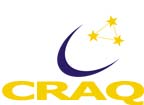2023 | 2022 | 2021 | 2020 | 2019 | 2018 | 2017 | 2016 | 2015 | 2014 | 2013 | 2012 | 2011 | 2010 | 2009 | 2008 | 2007
News 2010
The instrument SpIOMM at Mont-Mégantic deciphers the mysteries of the Crab nebula
(2010-12-06)
Guiding Light: The Canadian Space Agency “Eyes” Hubble’s Successor come from the CRAQ
(2010-09-08)
 The Canadian Space Agency has delivered a test unit of its contribution to the James Webb Space Telescope, successor of the Hubble Space Telescope, to NASA's Goddard Space Flight Center in Maryland. The Canadian Space Agency has delivered a test unit of its contribution to the James Webb Space Telescope, successor of the Hubble Space Telescope, to NASA's Goddard Space Flight Center in Maryland. |
Planet and star are indeed moving together
(2010-06-29)
Stellar cannibalism: a planet engulfed by a white dwarf star
(2010-06-21)
Simulations of Solar Cycles: cycles again!
(2010-06-18)
New submits for the Observatoire du Mont-Mégantic
(2010-01-11)
This web site is for Microsoft Internet Explorer and Firefox.

 A team of researchers from Laval University, all members of the CRAQ, produced the first 3D-map of the Crab nebula with the instrument SpIOMM at the Observatoire du Mont-Mégantic. This one-of-a-kind imaging spectrometer instrument was developed by graduate students under the supervision of Professor Laurent Drissen at the Department of Physics, Physical Engineering and Optics of Université Laval. It allows the simultaneous measurement of the velocity of gas filaments in a nebula which is then used to reconstruct a tridimensional representation.
A team of researchers from Laval University, all members of the CRAQ, produced the first 3D-map of the Crab nebula with the instrument SpIOMM at the Observatoire du Mont-Mégantic. This one-of-a-kind imaging spectrometer instrument was developed by graduate students under the supervision of Professor Laurent Drissen at the Department of Physics, Physical Engineering and Optics of Université Laval. It allows the simultaneous measurement of the velocity of gas filaments in a nebula which is then used to reconstruct a tridimensional representation. A planet about eight times the mass of Jupiter has been confirmed to orbit a Sun-like star that's some 300 times farther from its own star than Earth is from its sun. The newly confirmed planet is the least massive planet known to orbit at such a great distance from its host star. The discovery, first reported in September 2008, was made using high-resolution adaptive optics technology at the Gemini Observatory. These latest results, published in The Astrophysical Journal, were led by David Lafrenière of the University of Montreal Department of Physics and a researcher at the Center for Research in Astrophysics of Quebec.
A planet about eight times the mass of Jupiter has been confirmed to orbit a Sun-like star that's some 300 times farther from its own star than Earth is from its sun. The newly confirmed planet is the least massive planet known to orbit at such a great distance from its host star. The discovery, first reported in September 2008, was made using high-resolution adaptive optics technology at the Gemini Observatory. These latest results, published in The Astrophysical Journal, were led by David Lafrenière of the University of Montreal Department of Physics and a researcher at the Center for Research in Astrophysics of Quebec. A team of canadian and american astrophysicists led Patrick Dufour, postdoctoral researcher at the Physics Department of the Université de Montréal and member of the Centre de Recherche en Astrophysique du Québec (CRAQ), discovered, by examining thousands of spectra from the Sloan Digital Sky Survey, a white dwarf with the most metal-rich surface composition ever observed. Their analysis, based on observations from the Gemini North telescope (Hawaii) and the Multi-Mirror Telescope (MMT, Arizona) demonstrated clearly that a small planet-like object, with a mass equivalent to that of Ceres in our Solar System, sank inside a white dwarf star.
A team of canadian and american astrophysicists led Patrick Dufour, postdoctoral researcher at the Physics Department of the Université de Montréal and member of the Centre de Recherche en Astrophysique du Québec (CRAQ), discovered, by examining thousands of spectra from the Sloan Digital Sky Survey, a white dwarf with the most metal-rich surface composition ever observed. Their analysis, based on observations from the Gemini North telescope (Hawaii) and the Multi-Mirror Telescope (MMT, Arizona) demonstrated clearly that a small planet-like object, with a mass equivalent to that of Ceres in our Solar System, sank inside a white dwarf star. An international team led by Prof. Paul Charbonneau, member of the Physics department at the Université de Montreal and member of the Centre de Recherche en Astrophysique du Québec, developed the most accurate simulations of the Solar cycles up to this the moment.
An international team led by Prof. Paul Charbonneau, member of the Physics department at the Université de Montreal and member of the Centre de Recherche en Astrophysique du Québec, developed the most accurate simulations of the Solar cycles up to this the moment. The Observatoire du Mont-Mégantic (OMM) received a subsidy from the Canadian Foundation for Innovation (CFI), from the Québec government and from Universities, for a total of 11.7 millions of dollars. Those funds will be invested to support research and cutting-edge equipments and installations of international quality.
The Observatoire du Mont-Mégantic (OMM) received a subsidy from the Canadian Foundation for Innovation (CFI), from the Québec government and from Universities, for a total of 11.7 millions of dollars. Those funds will be invested to support research and cutting-edge equipments and installations of international quality.